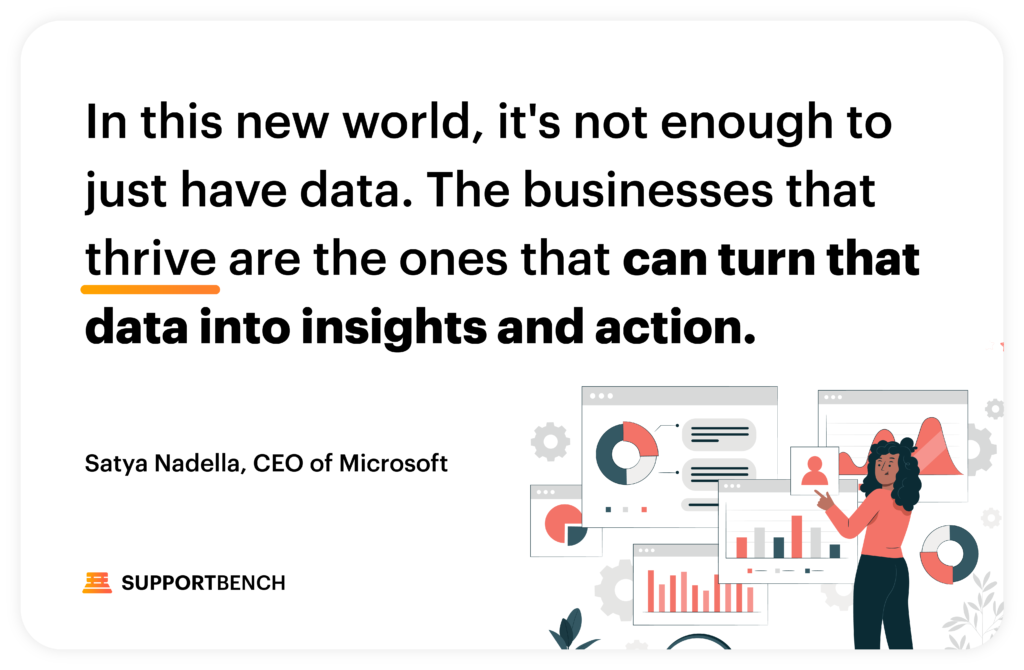In today’s digital age, businesses are generating more data than ever before. From sales figures and website analytics to customer feedback and service requests, every touchpoint generates valuable insights. However, if you’re not leveraging this data effectively, you might be missing out on essential clues about your customers.
The solution? 360-degree customer reporting. With comprehensive reporting, businesses can harness the power of their data to gain an all-encompassing view of their customers and drive more meaningful, personalized experiences.
The State of Customer Reporting Today

A recent study by Forrester found that 68% of businesses rank customer data analysis as a top priority for their operations. However, only 32% felt they were effectively utilizing this data. This discrepancy highlights a significant gap in modern business operations.
“In this new world, it’s not enough to just have data. The businesses that thrive are the ones that can turn that data into insights and action.” — Satya Nadella, CEO of Microsoft.
Unifying Disparate Data Sources
One of the greatest challenges faced by businesses is the siloed nature of data. Sales data might be in one system, while customer feedback is in another.
Integration of Systems
To combat this, businesses should invest in solutions that allow for seamless integration of various systems. This not only helps in consolidating data but also ensures that all departments are working from a unified source of truth. By integrating CRM systems with customer feedback platforms, support tickets, and other tools, businesses can create a holistic view of their customers. For instance, harmonizing CRM systems with feedback tools, or aligning support tickets with sales data, can craft a panoramic view of customer interactions. This unified approach not only streamlines operations but also fosters cross-departmental collaboration.
Satya Nadella, CEO of Microsoft, aptly sums it up: “In today’s data-driven era, merely amassing data isn’t a virtue. True success lies in converting this data into actionable insights.”
Case in Point: A multinational enterprise reported a transformational shift in customer retention by merging their CRM and feedback tools. The integrated insights allowed them to preemptively address potential dissatisfaction, reducing account attrition by an impressive 15% within a year.
Embracing Advanced Analytics
Basic data collection isn’t enough. Advanced analytics provide the means to dive deeper into customer behaviors, preferences, and pain points.
Invest in Advanced Analytics Tools

Consider tools that provide predictive analytics, sentiment analysis, and customer journey mapping. These tools offer insights beyond the surface, allowing businesses to understand not just what their customers are doing, but why they’re doing it. Enterprises must prioritize investment in these cutting-edge tools in order to make informed strategic pivots.
Example: A renowned tech company utilized sentiment analysis to gauge how their product launches were received. They adjusted their strategies based on real-time feedback, leading to more successful subsequent launches.
Prioritizing Customer Feedback
While businesses have access to myriad data sources, direct customer feedback remains one of the most valuable. It’s crucial not to overlook a time-tested tool
Regularly Solicit Feedback
Whether through NPS surveys, feedback forms, or direct interviews, consistently gather feedback. More importantly, act on it. Regular feedback loops can inform everything from product development to support strategies. But collection is just the first step—acting upon this feedback, integrating it into product development, and informing support strategies can lead to transformational shifts in customer satisfaction.
For example, Dropbox, an enterprise cloud storage solution, often incorporates direct customer feedback into product enhancements. This commitment to customer-centric development has played a significant role in their sustained success.
Visualization for Better Understanding
Data is only as useful as the insights derived from it. Visualization tools can transform raw data into comprehensible charts, graphs, and heatmaps.
Leverage Data Visualization Tools
Tools like Tableau or Power BI can be invaluable. By representing data visually, complex patterns and trends become immediately recognizable, aiding faster decision-making.
Example: Cisco, a global tech conglomerate, uses visualization tools to decipher global market trends. This enables them to make informed strategic decisions.
Training Teams to Be Data-Driven

Having access to data and tools is only part of the equation. Your team needs to be trained to interpret and act on this data. Indeed, a toolkit is only as good as the hands that wield it. In this context, those hands are your team members, who need the skills to decipher and leverage the data they’re presented with.
Invest in Regular Training
Regular workshops, courses, and training sessions can keep your team updated on the latest best practices in data analysis and reporting. This allocation of resources for consistent upskilling of your teams can prove invaluable.
For example, companies like Zappos have thrived by cultivating a data-driven culture. By emphasizing the importance of data in decision-making, they’ve fostered an environment where every team member understands and values customer insights.
Supportbench’s Different Approach
In the sprawling realm of 360-degree customer reporting, Supportbench emerges with a distinct voice as we understand the value of this. Our ethos emphasizes the profound value of holistic customer insights. The platform itself is designed to provide a comprehensive view of each customer, ensuring that businesses have the tools they need to drive exceptional customer experiences.
While we don’t sell solutions, we prioritize the seamless management of customer data, helping businesses to stay ahead of the curve. Supportbench is committed to creating an ecosystem that endorses exceptional customer management. Our focus is on creating an environment where support teams become organizational heroes, using data to drive decisions and shape customer interactions. This paradigm ensures that businesses remain dynamic, adaptive, and invariably customer-centric.
In the rapidly evolving landscape of business data, 360-degree customer reporting isn’t just a luxury—it’s an imperative. By harnessing the full power of their data, businesses can cultivate deeper relationships with their customers, driving growth and success in the modern digital age.
Companies that pivot their strategies to embrace this holistic approach will not only cultivate richer relationships with their customers but also position themselves as industry trailblazers!












